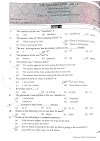Friction and its Laws
Frictional force is a contact force and operates in a direction so as to oppose relative motion of two bodies (surfaces) in contact.
Static and Kinetic Friction
Static Friction Kinetic Friction Frictional force acting between surfaces when there is no relative motion between them. Frictional force acting between surfaces when there is relative motion between them. self adjusting and variable force Constant force Origin of friction
According to the classical concept, the occurrence of frictional force is due to the interlocking of irregularities between surfaces in contact.
According to the modern concept, the occurrence of friction is due to intermolecular force between surfaces in contact. Hence, it has electrical origin.
Limiting Friction:
The maximum value of frictional force when it is just at the verge of motion when a force is applied is called limiting friction. ()
Frictional force (f) as a function of applied force (F)
Laws of Friction
The magnitude of the force of limiting friction between two bodies in contact is directly proportional to the normal reaction between them. i.e.
The direction of force of limiting friction is always opposite to the direction in which one body is at a verge of moving over the other.
The force of limiting friction is independent of apparent area of contact, so as long normal reaction between the two bodies remains the same.
The force of limiting friction between the two bodies in contact depends on the nature of the surface in contact.
Friction, Angle of Friction and Angle of Repose
Magnitude of Frictional Force
f ∝ R
Here, f is the frictional force, µ is the coefficient of friction and R is a normal reaction.
Thus,
Limiting frictional force,
For motion, kinetic frictional force,
Here, and are coefficients of static friction and coefficient of kinetic friction respectively.
Angle between resultant contact force and normal reaction is angle of friction.
From figure, and also,
Hence,
Angle of Repose
It is the angle of inclination of an inclined plane when the body just starts sliding down.
If Angle of inclination ,the obj slides.
Angle of Friction = Angle of Repose
Pushing and Pulling of Body
- Pushing and Pulling of Body
Here, If we want to write minimum force in both cases in terms of µ, then
Better You Know
- According to classical concept, occurrence of frictional force is due to interlocking of irregularities between surfaces in contact.
According to the modern concept, the occurrence of friction is due to intermolecular force between surfaces in contact. So, it has electrical origin.
Friction is a non-coservative force i.e. work done by frictional force depends upon path.
The frictional force depends on the nature of the sliding body and surface in contact.
Rolling friction Kinetic Friction Limiting Friction. i.e.
If the body is rolling a horizontal surface, the frictional force acts in same direction of rolling.
If the body is sliding in a horizontal surface, the frictional force acts in opposite direction.
A block takes n times as much time to slide down a rough inclined plane of inclination as it takes to slide down a perfectly smooth incline. The coefficient of kinetic friction between block and incline is given by
A block slides through a distance x on a smooth inclined plane of inclination and the blocks slide through distance on a rough inclined plane of the same inclination in equal time, then
If part of uniform chain overhangs from the edge of a horizontal surface, the coefficient of friction is
When a body of weight W is pressed against vertical wall by applying horizontal force F, total force exerted by wall on body is
If a time taken by block to slide down along rough inclined plane of inclination is n times the time taken by block to move up the same rough plane, coefficient of kinetic friction is
When a block is pulled by a force equal to its weight at an angle with vertical then block will be in motion if
When a block is pushed by a force equal to its weight at an angle with vertical then block will be in motion if
Stopping time and Stopping distance
A body moving in a horizontal plane with speed 'v'. It comes to rest after travelling distance s and time t due to friction. s and t are called stopping distance and stopping time.
and
Body Pressing Against Wall
For no falling of object
( As, Normal reaction R or N = F )
Hence,
Hanging of Chain
Let L be the length of chain of mass m and y be the length of chain that hangs over edge of table. L-y is the length of chain that lies on table.
For no falling,
i.e.
i.e.
represents a fraction of the length of the chain that can hang over the edge of the table.
Also,









0 Comments